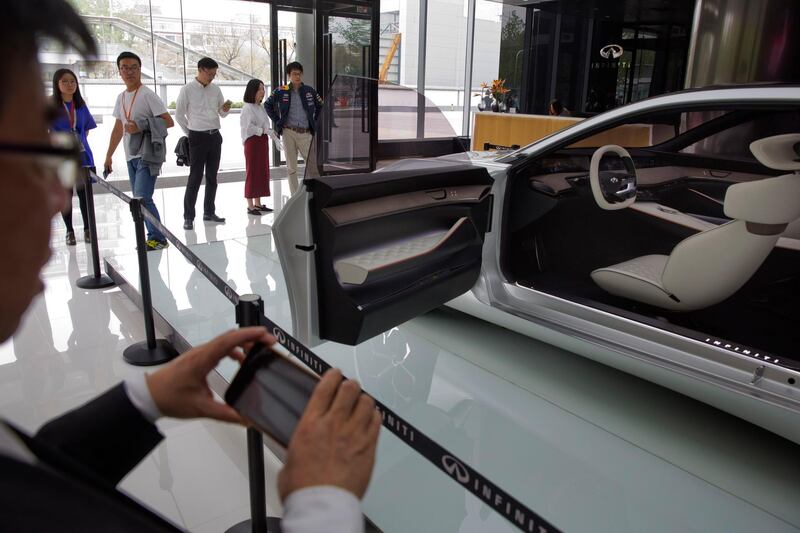An autonomous driving electric vehicle may not take to the sky any time soon but could one day start to look a bit like The Jetsons’ flying car - a glass bubble without the long hood that is a signature feature of today's gasoline-fueled cars.
The key game-changing technology behind that prospect is the electric motor - a relatively simple and compact propulsion system which allows car makers to eliminate the bonnet and the ample room underneath needed for a bulky internal combustion engine, engine cooling apparatus and complex transmission gears.
When that motor technology is combined with autonomous vehicle advances, the car not only no longer needs the bonnet but also what the industry calls crash zones.
The upshot: the EV shift might usher in the age of a bubble or pod-shaped car like those popularised by the 1960s futuristic animated comedy series, The Jetsons.
“That is the next logical step,” says Karim Habib, the design chief for Nissan's premium brand Infiniti.
“It is definitely the next step, particularly if you image a world of zero accidents with autonomous drive technology fully working. If cars will never crash, the ultimate most efficient [shape] of a personal mobility could be a glass cube.”
Going back to the 1920s, automobiles - especially luxury cars - have tended to have long bonnets, as the Tesla Model S does now. But that’s about to change.
At the Detroit car show in January, Infiniti showed a concept car whose styling points towards a not-so-distant future when most cars are going to be electrified.
The Q Inspiration Concept car, which is also being shown at the Beijing car show this week, has a shortened bonnet, an arcing, coupe-like roofline and 4x4-like interior room despite being a saloon.
Daimler’s Mercedes-Benz brand has also shown a concept car called the F015 that its wheels set close to the bumpers, and a large interior space under a dramatic roof line that arcs like a rainbow.
Forced in part by stringent fuel economy requirements and other regulations, car makers around world - especially in China - are scrambling to develop electric battery cars across a wide range of price points.
The technology shift is bringing to the industry change in the way cars are engineered and manufactured. In particular, because of the mechanical and structural simplicity of the EV, which have many fewer components than their gasoline car counterparts, offer greater opportunities for achieving commonality in vehicle platforms and components, as well as manufacturing processes.
Vehicle styling could be equally radical.
______________
Read more:
Ferrari uses silent treatment for electric-hybrid test
Toyota's electric push forces Yamaha to develop plug-in engines
______________
Some industry players such as Chinese-funded smart electric car start-up Byton think everyday cars, used for commuting and errands, will be much simplified if they are electrified and enabled by autonomous drive technology.
That’s because cars today are all “over spec’ed,” says Byton’s co-founder and chief executive Carsten Breitfeld.
Most have seats for four to seven people even though 70 per cent of the time those cars have just one or two people in them. Some have top speeds of 250kph, even though no one drives that fast.
Future everyday cars could shed all those over-specified features. They would have fewer seats, more luggage space and smaller wheels to further free up interior room because those future everyday cars don’t have to be capable of going 200kph.
They can be very boxy since there’s no need to make those lower-speed cars all that aerodynamic, Mr Breitfeld says.
“You’d design a smaller but roomy car for one or two passengers and make it more luxurious,” he says. “You could offer the kind of first-class experience you have in the commercial airplanes.”
Daimler believes the new generation of electric vehicles will have “a much longer wheelbase” to accommodate the batteries required for long range operation, says Johannes Reifenrath, head of product and powertrain strategy for the Mercedes-Benz brand.
The future Mercedes electric premium vehicles will provide a large interior space for passengers, with a shorter distance between the front bumper of the car and the front wheels.
Meanwhile, designer and managers at Infiniti, a second-tier premium car brand which has had trouble establishing a clear, differentiated positioning, believe the technology shift to electrification and autonomous drive offers an opportunity to reset the brand.
“Infiniti needs to find its own style,” says Christian Meunier, Infiniti’s division vice president for global sales and marketing. He believes electrification technology offers Infiniti a chance to inject more elegance and simplicity into automotive design.
“With EV, simplicity is going to be more and more.”






